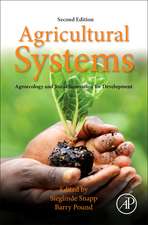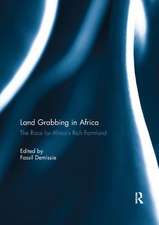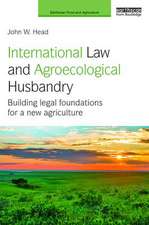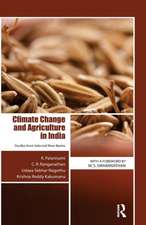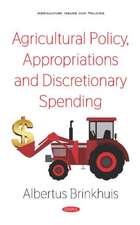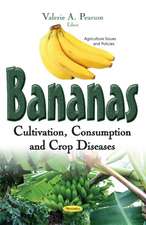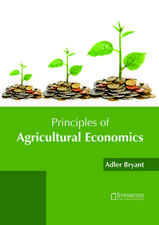The Communication Scarcity in Agriculture
Autor Jessica Eise, Whitney Hoddeen Limba Engleză Paperback – 14 iul 2016
This critical and timely book explains how changing demographics, cultural shifts, technological advances and agriculture’s silence all combined to create the perfect storm – a great chasm between those who know, and those who don’t know, agriculture. The ramifications of a poorly-informed consumer base are now becoming clear in our policy debates and consumer-driven business decisions. There is a lot of common ground between the agricultural sector and their consumer base, but each group largely fails to appreciate it, and the consequences of such a divide grow increasingly dire.
Drawing on a wide-range of expertise, from leading agricultural researchers to major agribusiness leaders to consumer advocates, Eise and Hodde lay out exactly why communication is so urgently critical to our modern-day agricultural system. They outline the major themes affecting agricultural communication – perception, emotion, technology, science - and what we can do now to improve the debate and safeguard our future food supply for generations to come.This book is suitable for those who study agriculture, environmental economics and mass media and communication.
| Toate formatele și edițiile | Preț | Express |
|---|---|---|
| Paperback (1) | 378.34 lei 6-8 săpt. | |
| Taylor & Francis – 14 iul 2016 | 378.34 lei 6-8 săpt. | |
| Hardback (1) | 872.70 lei 6-8 săpt. | |
| Taylor & Francis – 4 iul 2016 | 872.70 lei 6-8 săpt. |
Preț: 378.34 lei
Nou
Puncte Express: 568
Preț estimativ în valută:
72.40€ • 78.62$ • 60.82£
72.40€ • 78.62$ • 60.82£
Carte tipărită la comandă
Livrare economică 23 aprilie-07 mai
Preluare comenzi: 021 569.72.76
Specificații
ISBN-13: 9781138650619
ISBN-10: 1138650617
Pagini: 168
Dimensiuni: 129 x 198 x 32 mm
Greutate: 0.19 kg
Ediția:1
Editura: Taylor & Francis
Colecția Routledge
Locul publicării:Oxford, United Kingdom
ISBN-10: 1138650617
Pagini: 168
Dimensiuni: 129 x 198 x 32 mm
Greutate: 0.19 kg
Ediția:1
Editura: Taylor & Francis
Colecția Routledge
Locul publicării:Oxford, United Kingdom
Public țintă
General, Postgraduate, and UndergraduateCuprins
Foreword: Dr. Robert Paarlberg
Foreword: Dr. Sonny Ramaswamy
Preface: Today’s Communication Environment
Introduction: The Scarcity of Communication
Part One: The Reality
Chapter One: Pink Slime: When a media frenzy strikes
Chapter Two: Chipotle Marketing: Pushing polarization to the next level
Chapter Three: All That Glitters: The power of non-expert influence
Chapter Four: Triple for a Dozen: The rise and dominance of advocacy
Chapter Five: Technical Difficulties: Grappling with the benefits and risks of GMOs
Part Two: The Nuances
Chapter Six: Emotions and Agriculture
Pop-Out: Food and Health: A Consumer’s Perspective
Chapter Seven: Communicating the Essence of Agriculture
Pop-Out: Kids, Cows and Grass: A Farmer Blogger’s Perspective
Chapter Eight: The Importance of Perception
Pop-Out: For Better Communication, A Cultural Reorientation: A Policymaker’s Perspective
Chapter Nine: Turning Up the Volume on Science
Pop-Out: The Cost of Not Spending: An Academic’s Perspective
Part Three: A Reorientation
Chapter Ten: Working With, Not Against: The power of a diversity of perspectives
Chapter Eleven: Settling into Common Ground: The future of food and agriculture
Foreword: Dr. Sonny Ramaswamy
Preface: Today’s Communication Environment
Introduction: The Scarcity of Communication
Part One: The Reality
Chapter One: Pink Slime: When a media frenzy strikes
Chapter Two: Chipotle Marketing: Pushing polarization to the next level
Chapter Three: All That Glitters: The power of non-expert influence
Chapter Four: Triple for a Dozen: The rise and dominance of advocacy
Chapter Five: Technical Difficulties: Grappling with the benefits and risks of GMOs
Part Two: The Nuances
Chapter Six: Emotions and Agriculture
Pop-Out: Food and Health: A Consumer’s Perspective
Chapter Seven: Communicating the Essence of Agriculture
Pop-Out: Kids, Cows and Grass: A Farmer Blogger’s Perspective
Chapter Eight: The Importance of Perception
Pop-Out: For Better Communication, A Cultural Reorientation: A Policymaker’s Perspective
Chapter Nine: Turning Up the Volume on Science
Pop-Out: The Cost of Not Spending: An Academic’s Perspective
Part Three: A Reorientation
Chapter Ten: Working With, Not Against: The power of a diversity of perspectives
Chapter Eleven: Settling into Common Ground: The future of food and agriculture
Notă biografică
Jessica Eise is the Director of Communications in the Agricultural Economics Department at Purdue University, where she also teaches. She has a master’s in Journalism and International Relations from New York University. Eise worked internationally in communications for five years before a stint in Washington, DC, in policy communications.
Whitney Hodde is a Research Assistant in the Agricultural Economics Department at Purdue University. She has a master’s in Agricultural Economics from Purdue University. She was raised on a farm in Iowa and worked in Washington, DC, for seven years as an environmental finance expert in the non-profit world.
Whitney Hodde is a Research Assistant in the Agricultural Economics Department at Purdue University. She has a master’s in Agricultural Economics from Purdue University. She was raised on a farm in Iowa and worked in Washington, DC, for seven years as an environmental finance expert in the non-profit world.
Recenzii
‘The Communication Scarcity in Agriculture is in many ways a remarkable book. It takes on a set of very controversial topics related to communication on food and agricultural issues and handles them with a balance and perspective that is admirable. The authors review some very emotional cases – pink slime, Chipotles, celebrity bloggers, etc., and they are able to tell the story in an objective reporting manner. They recognize that many of the communication issues in food and agriculture arise because consumers are genuinely concerned about the safety of their food supply. They note that it is indeed unfortunate that some of the key players – farmers, ag businesses, and academics – have little incentive to actively participate in the communications task at hand. They are occupied with their jobs of improving the food system. Yet, the authors conclude, "if we are to create a future of agriculture that is sustainable and abundant, we need to include all stakeholders and cease to perceive communications as secondary in our efforts."’ — Wallace E. Tyner, James and Lois Ackerman Professor of Agricultural Economics, Purdue University, West Lafayette, IN, USA
‘There’s a lot of talking about food and agriculture but meaningful conversation is much lacking. Eise and Hodde help shed light on the communication problems facing agriculture, and provide insights on how farmers, scientists, and advocates can meaningfully engage with the public.’ — Jayson Lusk, Professor of Agricultural Economics and author of Unnaturally Delicious
‘From pink slime media frenzy to GMOs to agribusiness reputations The Communication Scarcity in Agriculture provides an adeptly, well-sourced analysis of the current of state of agricultural communications. The authors draw a dramatic parallel between what has happened in modern agriculture to what is happening in communications. While awareness and participation in agriculture decreases the blast of new media exists in a second-to-second news cycle that routinely lands on high profile, high response issues. Revealing part of the picture has become the new standard rather than delving into the science of issues to reveal the complex whole. The Communication Scarcity in Agriculture emits a call to all involved---from agriculture academics and agribusinesses to worldwide corporations to the media to consumers---to ask the hard questions, to listen to the detailed explanations, and to seek the conversations in which the seeds for a better informed future can be planted.’ — Maureen Manier, Department Head of Agricultural Communication at College of Agriculture, Purdue University, USA.
‘Eise and Hodde strike to the very heart of what is perhaps modern agriculture’s most serious challenge — a challenge that, if not overcome, could ultimately inhibit our future. Citing both well-known and lesser-known examples from our industry, they show in great detail the perils of under-communicating with consumers in an age of media explosion. But the key, they explain, is not simply more communication. Today’s consumers are deeply engaged in emotional issues surrounding the health and well-being of themselves, their families and their planet. The answers they seek will come not only through good science and solid information, but through voices of understanding. Eise and Hodde issue to us a charge to listen and identify, to find common ground with consumers who are concerned, and to engage with them in a very open and sincere dialogue that will advance our industry and society as a whole.’ — Josh Woods, Director of Communications and Marketing, Auburn University College of Agriculture, USA
‘There’s a lot of talking about food and agriculture but meaningful conversation is much lacking. Eise and Hodde help shed light on the communication problems facing agriculture, and provide insights on how farmers, scientists, and advocates can meaningfully engage with the public.’ — Jayson Lusk, Professor of Agricultural Economics and author of Unnaturally Delicious
‘From pink slime media frenzy to GMOs to agribusiness reputations The Communication Scarcity in Agriculture provides an adeptly, well-sourced analysis of the current of state of agricultural communications. The authors draw a dramatic parallel between what has happened in modern agriculture to what is happening in communications. While awareness and participation in agriculture decreases the blast of new media exists in a second-to-second news cycle that routinely lands on high profile, high response issues. Revealing part of the picture has become the new standard rather than delving into the science of issues to reveal the complex whole. The Communication Scarcity in Agriculture emits a call to all involved---from agriculture academics and agribusinesses to worldwide corporations to the media to consumers---to ask the hard questions, to listen to the detailed explanations, and to seek the conversations in which the seeds for a better informed future can be planted.’ — Maureen Manier, Department Head of Agricultural Communication at College of Agriculture, Purdue University, USA.
‘Eise and Hodde strike to the very heart of what is perhaps modern agriculture’s most serious challenge — a challenge that, if not overcome, could ultimately inhibit our future. Citing both well-known and lesser-known examples from our industry, they show in great detail the perils of under-communicating with consumers in an age of media explosion. But the key, they explain, is not simply more communication. Today’s consumers are deeply engaged in emotional issues surrounding the health and well-being of themselves, their families and their planet. The answers they seek will come not only through good science and solid information, but through voices of understanding. Eise and Hodde issue to us a charge to listen and identify, to find common ground with consumers who are concerned, and to engage with them in a very open and sincere dialogue that will advance our industry and society as a whole.’ — Josh Woods, Director of Communications and Marketing, Auburn University College of Agriculture, USA
Descriere
This critical and timely book explains how changing demographics, cultural shifts, technological advances and agriculture’s silence all combined to create the perfect storm – a great chasm between those who know, and those who don’t know, agriculture. The ramifications of a poorly-informed consumer base are now becoming clear in our policy debates and consumer-driven business decisions. There is a lot of common ground between the agricultural sector and their consumer base, but each group largely fails to appreciate it, and the consequences of such a divide grow increasingly dire.

